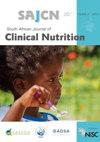Screening for overweight using mid-upper arm circumference (MUAC) among children younger than two years in the Eastern Cape, South Africa
IF 0.6
Q4 NUTRITION & DIETETICS
引用次数: 1
Abstract
Background: The relationship between overweight and under-nutrition, particularly in resource-poor settings, poses practical challenges for targeting nutrition interventions. Current anthropometric indicators including weight for length (WLZ) recommended by the WHO may be challenging in community settings. Objectives: The aim of this study was to assess whether MUAC can accurately identify children aged younger than two years with overweight and obesity. Method: A descriptive, cross-sectional study was used to collect data from a non-probability sample of 397 young South African children from October 2015 to February 2016. MUAC cut-off values were tested using a receiver operating characteristic and area under the curve (AUC). Results: The prevalence of overweight (WLZ > +2) and obesity (WLZ > +3) was 11% (n = 44) and 5% (21) respectively. A MUAC cut-off value for identifying male children 6 to 24 months old with overweight was determined at 16.5 cm (85% sensitivity, 71.4% specificity, AUC = 0.821) and female children at 16.5 cm (100% sensitivity, 76.6% specificity, AUC = 0.938). Conclusions: MUAC may be an appropriate tool for identifying children younger than two years old with overweight and obesity. The predicted MUAC cut-off values were able to identify infants and young children with overweight accurately.南非东开普省两岁以下儿童中上臂围筛查超重
背景:超重和营养不足之间的关系,特别是在资源匮乏的环境中,对营养干预的目标提出了实际挑战。目前的人体测量指标,包括世界卫生组织推荐的体重与长度(WLZ),在社区环境中可能具有挑战性。目的:本研究的目的是评估MUAC是否能够准确识别两岁以下超重和肥胖儿童。方法:采用描述性横断面研究,从2015年10月至2016年2月的397名南非幼儿的非概率样本中收集数据。使用受试者工作特性和曲线下面积(AUC)测试MUAC截止值。结果:超重(WLZ>+2)和肥胖(WLZ>+3)的患病率分别为11%(n = 44)和5%(21)。确定6至24个月大超重男性儿童的MUAC临界值为16.5 cm(灵敏度85%,特异性71.4%,AUC = 0.821)和16.5岁的女性儿童 cm(100%灵敏度,76.6%特异性,AUC = 0.938)。结论:MUAC可能是识别两岁以下超重和肥胖儿童的合适工具。预测的MUAC临界值能够准确识别超重婴儿和幼儿。
本文章由计算机程序翻译,如有差异,请以英文原文为准。
求助全文
约1分钟内获得全文
求助全文
来源期刊

South African Journal of Clinical Nutrition
NUTRITION & DIETETICS-
CiteScore
2.50
自引率
9.10%
发文量
21
期刊介绍:
1.The Journal accepts articles from all basic and applied areas of dietetics and human nutrition, including clinical nutrition, community nutrition, food science, food policy, food service management, nutrition policy and public health nutrition. 2.The Journal has a broad interpretation of the field of nutrition and recognizes that there are many factors that determine nutritional status and that need to be the subject of scientific investigation and reported in the Journal. 3.The Journal seeks to serve a broad readership and to provide information that will be useful to the scientific community, the academic community, government and non-government stakeholders in the nutrition field, policy makers and industry.
 求助内容:
求助内容: 应助结果提醒方式:
应助结果提醒方式:


